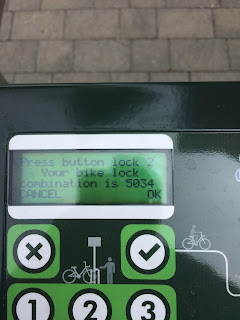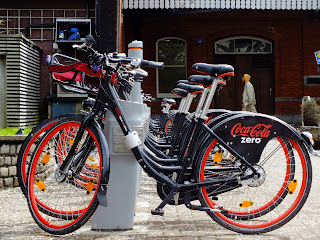The Cycle of life? - Comparing Bike Sharing Systems
It is admittedly kind of surprising. I’m not the most sporty guy to put it mildly, yet for the last year or so, I have really taken a liking to cycling. Not the pseudo sporty “30 year beer gut, but dressing like Lance Armstrong” kind, mind you, I do have some modesty. I’m more along the lines of getting from A to B in a speedy manner, and if you don’t have a car, a bike is pretty much your best option. However, owning a bike in an urban environment inevitable brings up storage issues, maintenance, etc. Thankfully, there are a number of alternatives to this in the meantime, you guessed it, bike sharing systems.
Yaaaaawwwnnn. Didn’t you already write about that? I did actually, and quite extensively, when I wrote my original report about Coca Cola Zero Bikes, the local bike sharing system here in Cork. However, I have since been able to test two more similar systems, and of course Coca Cola Zero Bikes has now been in operation for a year, so it is more than fair game to check in on that again as well. In fact, I’ll start this article off with my assessment of how Coke Zero Bikes is doing one year on before moving on to the other two systems.
Coca Cola Zero Bikes Cork
Website: www.bikeshare.ie
It is quite simply the system I am most familiar with, although I haven’t been one one of those bikes for quite some time, due to an accident last August, which seriously cut down my mobility, and to be fair, the weather hasn’t helped much either. Still, one year on, I am still impressed with the system, its practicality and low cost, being easily the cheapest of the three systems I’ll touch on in this article. The statistics read impressive as well. 31 Stations, 330 Bikes, and that is for Cork alone. The coverage area is pretty good as well, covering just about the entire downtown area between Kent Station and Fitzgerald Park and University College Cork.
 |
| Between Kent Station on the eastern end of the city.... |
 |
| ... and Bandfield just outside the entrance to UCC, Coke Zero Bikes really covers the entire inner city. |
 |
| Stations at transport hubs like Parnell Place Bus Station really seem to indicate the birth of some kind of intermodal transport network |
In the months after opening, the system caught some flak over the fact that the state of repair of the bikes seemed to go down, with the textile straps on the handlebar baskets being noticeably loose and “wobbly”, as well as the usual wear and tear of objects being left out in the open for drunk pub crawlers to have some “fun” with overnight. The basket issue (or should I write basket case?) was sorted out with the textile straps being replaced by leather, which feels solid enough to be bullet proof. As for the bike frames themselves, my original assertion still stands: “The bikes themselves are solid, really solid. Like "cut from a battleship hull" solid.”
That’s not to say that everything is perfect. Over the last few months, a number of stations have gone offline without any detailed explanation or information when they’ll go back online. The station at Brian Boru Bridge is the sad record holder here, being offline since July. So, communication is a bit lacking, the Service Updates section of the website not really holding any updates at all, and contact options being limited to phone and email. What about social media? Facebook? Twitter? Hell, even Google Plus would be better than the current situation, especially as the system covers not only Cork but als Limerick and Galway, not really minor cities, at least on an Irish scale.
Still, given the rough conditions the system is operating in, it is holding up remarkably well. The bikes are the most comfortable of the three systems in this article, and I’ve already mentioned the price, which is a steal at 10€ a year, with the first 30 minutes of every rental being free. Plus, those bikes just look damn good in their black, red, and white paint scheme!
Citybike Liverpool
Website: https://www.citybikeliverpool.co.uk
I was absolutely blown away by the city of Liverpool during my visit there in June 2015. The same could not be said about the local bike rental system Citybike Liverpool, however. Granted, the system is the biggest single system I’ll cover in this article, encompassing 1000 bikes available at 140 stations throughout the city and metro area, and ANY city that decides to invest in a bike sharing system has made a right decision in my eyes. Still, the system isn’t quite up to scratch to be honest.
 |
| It really doesn't get more minimalistic than these terminals. Still, all you need is there. |
 |
| Those keypads look robust, that much is for sure. |
Registering and renting the bikes is pretty straightforward, though you enter your customer number manually instead of swiping a membership card, and there are certainly enough stations around, as I wrote earlier. No fancy high-res colour displays here, though. Instead, you get a monochrome display and a keyboard that wouldn’t look out of place on a 1980’s ATM. The issue with Citybike Liverpool isn’t with the stations however, it is with the bikes.
 |
| I wish these bikes were as solid as the other ones mentioned in this article. |
On the face, they are just what you’d expect from a rental bike. Distinctive colour scheme, a basket to carry light loads on the handlebar, as well as an easily adjustable saddle. However, that’s where the similarities to other networks end. First of all, these bikes are quite a bit shorter than their competitors of Coke Zero Bikes or Nextbike, the next guys in this report. The Liverpool bikes also have smaller wheels, and a much harder saddles. Quite frankly, they feel rickety, like those fold-up bikes that you sometimes see. That’s not to say they don’t have their advantages. The rubber straps to secure bags, etc. in the front basket is a good idea, and the fact that the “docking pin” is right in front of the bike, rather than on the frame in a “shin killer” configuration like in Cork will definitely avoid bruises and fluent, if unoriginal curses. Still, there are better systems out there.
Nextbike Speyer
Website: http://www.nextbike.de/en/
Nextbike is a bit the odd one out here in this article. While the other systems mentioned are either supported by an advertising company or by a local council, Nextbike operate under their own name. They’re also a true global player in their sector, offering bikes not just in Germany, where I tested them, but on 4 continents, offering 25000 bikes to rent. With a rental network stretching from Pittsburgh, Pennsylvania, to Auckland New Zealand, it is truly a remarkable company.
While I had known about the company ever since a friend and former colleague of mine had told me about their operations in Frankfurt, my first actual contact with them was while visiting my parents in Speyer over Christmas. As some of you may have noticed, large parts of central and western Europe experienced an unusually mild christmas season this year, so hopping down to the city centre on a bike to do some last minute shopping wasn’t too out of the ordinary, or indeed to chilly.
 |
| Once again, you have your standard bikesharing setup, with docking pylons and terminal. |
Once again, registration was quick and easy online, that is something that all three systems described in this article have in common. Checking out a bike was a bit of a longer process here, as once again you don’t automatically have a customer card, and the system identifies you with your mobile phone number, including country code. On the upside, you can still rent a bike even if the terminal has failed, simply by using the respective app for your smartphone. Instructions for this are clearly written on the terminal, a major plus for usability. The unusual thing here is that you don’t choose your bike, rather you are simply given one.
 |
| The bikes are really practical, not just for short trips. |
The bikes themselves are rock solid. While they admittedly do not have the “battleship” feel of the bikes here in Cork, they are more than solid enough to get the job done. In addition to the usual handlebar basket, these bikes have a full size luggage rack over the rear wheel, so doing shopping with these things is much more practical than with the other bikes on this list. With clear instructions on how to check out and return the bike on the luggage rack, you really can’t do much wrong here. People will still get the process wrong though, I’m sure. I’ve been in customer service too long to expect otherwise.
 |
| Between the writing on the terminals and here on the rack, there really shouldn't be any way to make a mistake when renting or returning a bike. |
What really sets these bikes apart is their handling. They are right up there with the Coke Zero Bikes in Cork for that matter. The transmission is excellent, although not an infinite system like with the Cork bikes, and even negotiating cobblestones at low speed, a nightmare for every cyclist, is not a real issue here. Those guys in Liverpool can really take a lesson or two from these bikes. Not all that glitters is gold though, and the saddle on these bikes is nothing to write home about.
So, what else is there to say? Not much to be honest. I’ve become a full blown advocate for systems of this kind, all three of them. Yep, even the Liverpool system, with its questionable bikes is definitely something I’d use on a regular basis. Our cities simply aren’t able to cope with additional car traffic, and systems like those three are a good way to reduce the number of cars on the road. If you live in a city already covered by a bike sharing system, use it, and if there is a system being set up in your area, support it. There really isn’t a much easier way to get cars out of the cities.










Your Blog content is very good. Thanks for sharing the information.
ReplyDeleteLudhiana bicycle Industry